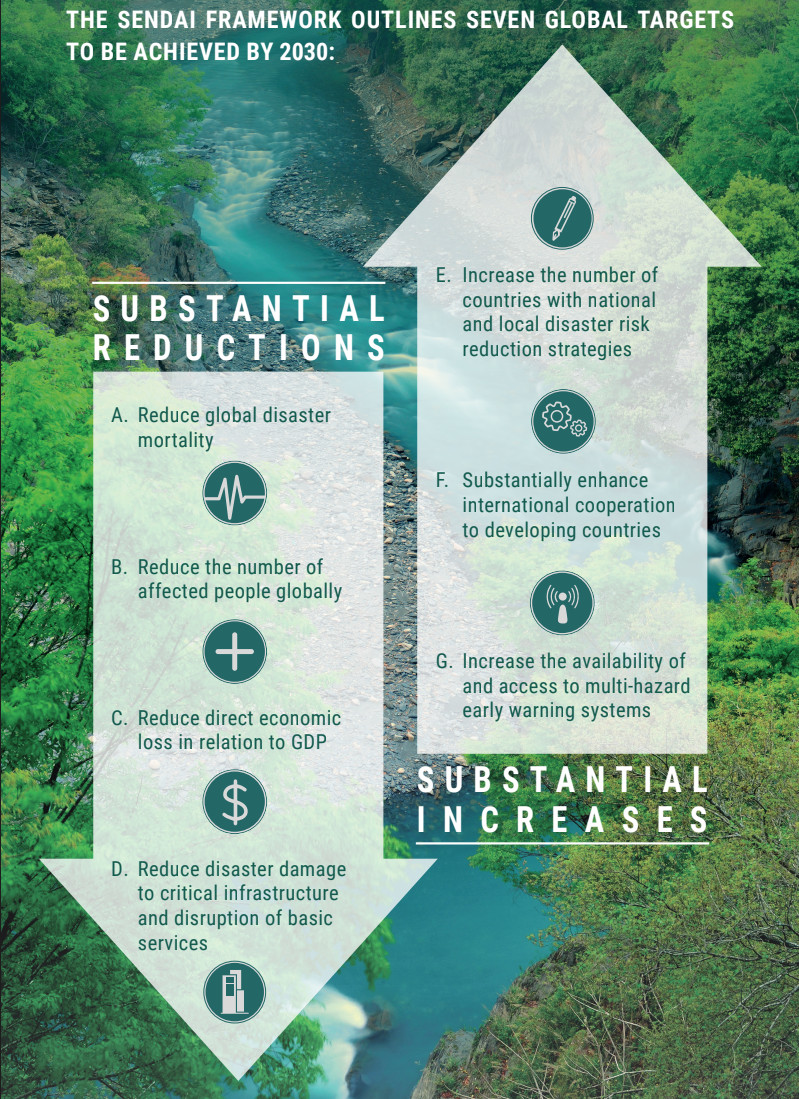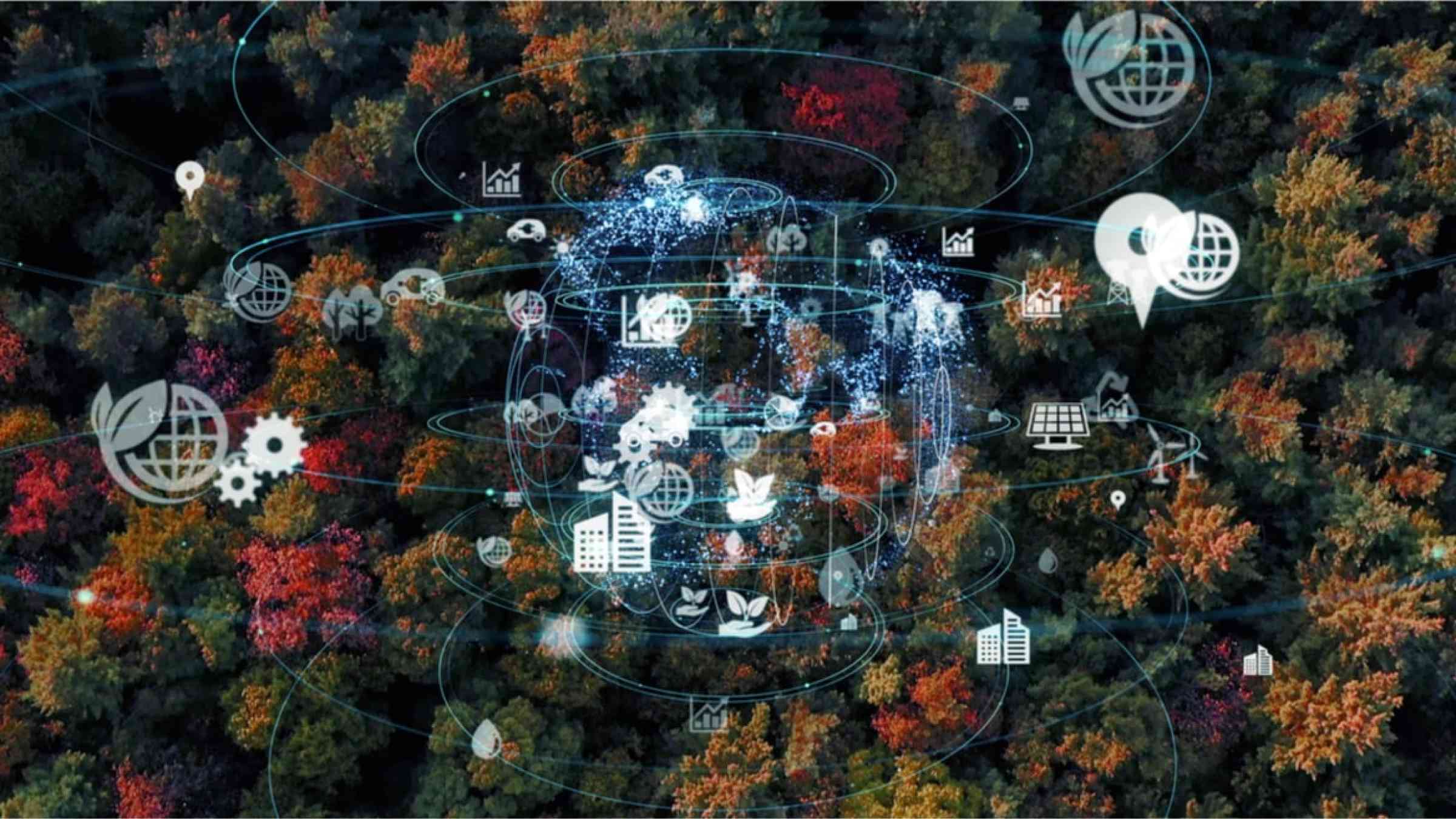Key international agreements
Key international agreements
Global frameworks provide a comprehensive foundation for states to improve disaster risk reduction.
The Sendai Framework for Disaster Risk Reduction

In March 2015, UN member states agreed on a 15-year plan to reduce disaster risk by 2030 by endorsing the Sendai Framework for Disaster Risk Reduction 2015-2030, which was adopted at the Third World Conference on Disaster Reduction, in Sendai, Japan.
The Sendai Framework is a non-binding agreement which succeeds the Hyogo Framework for Action (HFA) 2005-2015. Its goal is to reduce disaster losses by reducing existing levels of disaster risk and preventing the creation of new risk by reducing exposure and vulnerability and increasing preparedness and strengthening resilience.
The Sendai Framework is aligned with the other 2030 Agenda framework agreements, including The Paris Agreement on Climate Change, the Addis Ababa Action Agenda on Financing for Development, the New Urban Agenda and, ultimately, the Sustainable Development Goals.
It recognises that the State has the primary role to reduce disaster risk but that responsibility should be shared with other stakeholders including local government, civil society actors, the private sector and others.
UNDRR is tasked to support the implementation, follow-up and review of the Sendai Framework.

Seven targets of the Sendai Framework
To substantially reduce:
A. Global disaster mortality
B. The number of people affected
C. Direct losses in relation to GDP
D. Disaster damage to critical infrastructure and disruption of basic services, and
To substantially increase:
E. The number of countries with national and local disaster risk reduction strategies
F. International cooperation to developing countries for implementation of this framework
Four priorities of the Sendai Framework
1. Understanding disaster risk
2. Strengthening disaster risk governance to manage disaster risk
3. Investing in disaster risk reduction for resilience
4. Enhancing disaster preparedness for effective response
8th anniversary of the adoption of the Sendai Framework
In March 2023, Sendai Framework implementation crossed its midpoint. Noting that the world is still a long way away from realising the goals of Sendai, Mami Mizutori, Head of UNDRR and the Special Representative of the Secretary-General for Disaster Risk Reduction said:
“We owe it to the millions who have been affected by disasters worldwide to learn from past mistakes and to build back better in the remaining years of the Sendai Framework and the 2030 Agenda.
This means transforming decision-making to deliver resilience for all.”
Monitoring progress under the Sendai Framework
Strong accountability is one of the cornerstones of the Sendai Framework for Disaster Risk Reduction. A set of 38 indicators has been identified by the Open-ended Intergovernmental Expert Working Group to track progress across the Sendai Framework’s seven targets and the associated Sustainable Development Goals (SDGs). This set of indicators allows the tracking of progress within each country and region, as well as global trends in DRR.
The Sendai Framework Monitor is a management tool to help countries develop disaster risk reduction strategies, make risk-informed policy decisions and allocate resources to prevent new disaster risks. It offers journalists a template with which to explore various dimensions of their country’s progress in implementing DRR measures. It can be used to report on legislation and other measures within their countries.

The UN Framework Convention on Climate Change

The UN Framework Convention on Climate Change (UNFCCC) is an international treaty that nearly 200 governments adopted in 1992 with the aim of preventing dangerous climate change. It is the parent treaty of the 1997 Kyoto Protocol as well as the 2015 Paris Agreement. The ultimate objective of the UNFCCC and its associated agreements is to stabilize greenhouse gas concentrations in a time frame which allows ecosystems to adapt naturally and enables sustainable development.
The signatories come together on a regular basis to review progress and negotiate new action during the Conference of Parties (COP). Through this treaty, COP3 produced the Kyoto Protocol, the agreement that required some industrialised countries to reduce their emissions of greenhouse gases. At the COP21 in December 2015, the Paris Agreement produced and brought about unprecedented cooperation for governments to reduce greenhouse gas emissions.
In November 2022, COP27 in Sharm el-Sheikh, Egypt, closed with a breakthrough agreement to provide “loss and damage” funding for vulnerable countries as well as a package of other decisions to limit global temperature rise to 1.5 degrees Celsius above pre-industrial levels.
The Paris Agreement

The Paris Agreement builds upon the UNFCCC and for the first time brings 178 nations together to undertake ambitious efforts to combat climate change, adapt to its effects, and provide enhanced support to developing countries to do so.
Its central aim is to strengthen the global response and restrict global temperature rise in the 21st Century to below 2 degrees Celsius above pre-industrial levels, and to strive to limit it to 1.5 degrees Celsius.
The Agreement aims to put in place appropriate financial flows, a new technology framework and an enhanced capacity building framework to help achieve this ambitious goal.
What is the Paris Agreement?
Dive deeper into the Paris Agreement and learn about how it works, long-term strategies, achievements to date, and how the UNFCCC tracks progress.
Learn more
Sustainable Development Goals
No One Left Behind

Heads of State, Government leaders, UN High Level Representatives and civil society met at the 70th Session of the United Nations General Assembly and adopted the Sustainable Development Goals (SDGs) in September 2015.
The 17 SDGs are the world's best plan to build a better world for people and our planet by 2030. They are a call for action by all countries – poor, rich and middle-income – to promote prosperity while protecting the environment.
They recognize that ending poverty must go together with strategies that build economic growth and address a range of social needs including education, health, equality and job opportunities, while tackling climate change and working to preserve our ocean and forests.
SDGs – the 17 goals in brief
1. No poverty
2. Zero hunger
3. Good health and well-being
4. Quality education
5. Gender equality
6. Clean water and sanitation
7. Affordable and clean energy
8. Decent work and economic growth
9. Industry, innovation and infrastructure
10. Reduced inequalities
11. Sustainable cities and communities
12. Responsible consumption and production
13. Climate action
14. Life Below Water
15. Life on Land
16. Peace, Justice, and Strong Institutions
17. Partnerships for the Goals


The Sendai Framework’s contribution to the SDGs
The Sendai Framework was the first development agreement adopted in 2015. It was followed by the adoption of the 17 Sustainable Development Goals and 2030 Development Agenda by the General Assembly in New York in September 2015 and the new agreement on Climate Change in Paris in December 2015.
Disaster risk reduction is essential to achieve the 17 Sustainable Development Goals and, in particular, three of them:
- Goal 1: End poverty in all its forms everywhere
- Goal 11: Make cities and human settlements inclusive, safe, resilient and sustainable, and
- Goal 13: Take urgent action to combat climate change and its impacts

10 things to know about the Sendai disaster risk reduction deal
International agreements – whatever subject they address – are never going to make everyone happy. The same is true for the new global disaster risk reduction plan, adopted after a 40-hour negotiating session in Japan last week.
The Sendai framework is built to last for the next 15 years, and as the first of three major deals due to be struck this year on sustainable development and climate change, it attracted a high level of political interest – certainly more than usual for the theme.
